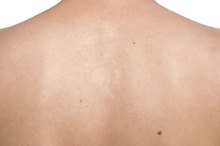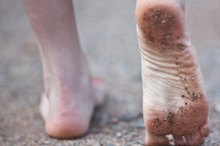What does fact checked mean?
At Healthfully, we strive to deliver objective content that is accurate and up-to-date. Our team periodically reviews articles in order to ensure content quality. The sources cited below consist of evidence from peer-reviewed journals, prominent medical organizations, academic associations, and government data.
The information contained on this site is for informational purposes only, and should not be used as a substitute for the advice of a professional health care provider. Please check with the appropriate physician regarding health questions and concerns. Although we strive to deliver accurate and up-to-date information, no guarantee to that effect is made.
The Skin on My Big Toe Is Peeling
Athlete’s foot, a common fungal infection, causes peeling, itching and stinging skin on the big toe 12. The fungus can also spread to the toenails, resulting in crumbling. Your chances of getting a fungal infection increase when the skin is wet for long periods of time. Men are also more likely to get athlete’s foot, according to MayoClinic.com 12. Fortunately, this infection is easily treated.
If you are experiencing serious medical symptoms, seek emergency treatment immediately.
Causes
A group of fungi called dermatophytes is responsible for athlete’s foot infections 12. The infection is highly contagious and transfers through contact with an infected person. Contact with contaminated items, such as floors, towels or shoes, spreads athlete's foot 12. The fungus thrives in damp places and in humid conditions.
Treatments
Itchy Skin Between the Toes
Learn More
An over-the-counter medication such as butenafine or clotrimazole treats athlete's foot infections 12. Use the medication and directed and keep the feet dry. If nonprescription methods aren’t getting rid of big toe peeling, contact your doctor. She can provide a prescription-strength topical antifungal medication, such as clotrimazole or miconazole, notes MayoClinic.com 2. Oral medications, such as fluconazole and terbinafine, are able to treat athlete's foot infections that don’t respond to other treatment methods 12.
Prevention
Avoid bare feet while in public places, such as locker rooms and pools. Select socks made from natural materials, like cotton, recommends MayoClinic.com 2. If socks are damp, change them quickly to prevent creating a warm, wet environment in which fungus can grow. Purchase shoes made of rubber or vinyl, which provides better ventilation for the feet.
Using an antifungal powder on the feet daily also can help prevent athlete’s foot infections 12. Dry between the toes to get rid of excess moisture.
- Avoid bare feet while in public places, such as locker rooms and pools.
- Purchase shoes made of rubber or vinyl, which provides better ventilation for the feet.
Considerations
Bumps in a Circle on the Skin
Learn More
Avoid scratching athlete's foot infections 12. Scratching makes inflammation worse and puts you at higher risk for bacterial infection. If the toe becomes inflamed and irritated, contact your doctor. She can treat the secondary bacterial infection and assist with clearing up athlete’s foot 12.
Warnings
If you have a weak immune system, you are at higher risk for developing athlete’s foot, according to MayoClinic.com 12. Talk with your doctor about preventive measures, such as using a daily powder if you develop frequent outbreaks of athlete’s infection. This will help avoid bacteria growth.
Related Articles
References
- MedlinePlus: Athlete's Foot
- MayoClinic.com: Athlete's Foot
- American Academy of Dermatology: Fungal Infections of the Skin
- Abd Elmegeed AS, Ouf SA, Moussa TA, Eltahlawi SM. Dermatophytes and other associated fungi in patients attending to some hospitals in Egypt. Braz J Microbiol. 2015;46(3):799–805. doi:10.1590/S1517-838246320140615
- Homei A, Worboys M. Fungal Disease in Britain and the United States 1850–2000: Mycoses and Modernity. Basingstoke (UK): Palgrave Macmillan; 2013. Chapter 2, Athlete’s Foot: A Disease of Fitness and Hygiene. Available from: https://www.ncbi.nlm.nih.gov/books/NBK169220/
- InformedHealth.org [Internet]. Cologne, Germany: Institute for Quality and Efficiency in Health Care (IQWiG); 2006-. Nail fungus: Overview. 2015 Jan 14 [Updated 2018 Jun 14].Available from: https://www.ncbi.nlm.nih.gov/books/NBK279547/
- InformedHealth.org [Internet]. Cologne, Germany: Institute for Quality and Efficiency in Health Care (IQWiG); 2006-. Athlete's foot: Overview. 2015 Jan 14 [Updated 2018 Jun 14].Available from: https://www.ncbi.nlm.nih.gov/books/NBK279549/
- Nigam PK, Saleh D. Tinea Pedis. [Updated 2019 Nov 25]. In: StatPearls [Internet]. Treasure Island (FL): StatPearls Publishing; 2019 Jan-. Available from: https://www.ncbi.nlm.nih.gov/books/NBK470421/
- Leyden JJ, Kligman AM. Interdigital athlete's foot: new concepts in pathogenesis. Postgrad Med. 1977;61(6):113-6.
- Blutfield MS, Lohre JM, Pawich DA, Vlahovic TC. The Immunologic Response to Trichophyton Rubrum in Lower Extremity Fungal Infections. J Fungi (Basel). 2015;1(2):130–137. doi:10.3390/jof1020130
- Al Hasan M, Fitzgerald SM, Saoudian M, Krishnaswamy G. Dermatology for the practicing allergist: Tinea pedis and its complications. Clin Mol Allergy. 2004;2(1):5. Published 2004 Mar 29. doi:10.1186/1476-7961-2-5
- Chollet A, Cattin V, Fratti M, Mignon B, Monod M. Which Fungus Originally was Trichophyton mentagrophytes? Historical Review and Illustration by a Clinical Case. Mycopathologia. 2015;180(1-2):1-5. doi:10.1007/s11046-015-9893-2
- Newland JG, Abdel-Rahman SM. Update on terbinafine with a focus on dermatophytoses. Clin Cosmet Investig Dermatol. 2009;2:49–63. Published 2009 Apr 21. doi:10.2147/ccid.s3690
- Hainer BL. Dermatophyte infections. Am Fam Physician. 2003;67(1):101-8.
- Jimenez-garcia L, Celis-aguilar E, Díaz-pavón G, et al. Efficacy of topical clotrimazole vs. topical tolnaftate in the treatment of otomycosis. A randomized controlled clinical trial. Braz J Otorhinolaryngol. 2019.
- Lestner J, Hope WW. Itraconazole: an update on pharmacology and clinical use for treatment of invasive and allergic fungal infections. Expert Opin Drug Metab Toxicol. 2013;9(7):911-26.
Writer Bio
Nicki Howell started her professional writing career in 2002, specializing in areas such as health, fitness and personal finance. She has been published at health care websites, such as HealthTree, and is a ghostwriter for a variety of small health care organizations. She earned a Bachelor of Science in business administration from Portland State University.








